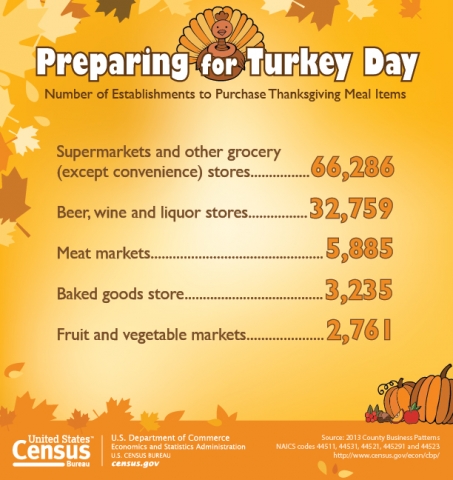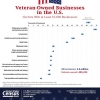Nov252015
Posted at 10:00 AM
In the fall of 1621, the Pilgrims — early settlers of Plymouth Colony — held a three-day feast to celebrate a bountiful harvest. This event is regarded by many as the nation’s first Thanksgiving. The Wampanoag Indians in attendance played a key role. Historians have recorded ceremonies of thanks among other groups of European settlers in North America. These include the British colonists in Virginia as early as 1619.
The legacy of thanks and the feast have survived the centuries, as the event became a national holiday 152 years ago (Oct. 3, 1863) when President Abraham Lincoln proclaimed the last Thursday of November as a national day of thanksgiving. Later, President Franklin Roosevelt clarified that Thanksgiving should always be celebrated on the fourth Thursday of the month to encourage earlier holiday shopping, never on the occasional fifth Thursday.
Following are some key statistics released by the U.S. Census Bureau in recognition of Thanksgiving Day: Nov. 26, 2015.
117 million
Number of occupied housing units across the nation in the second quarter of 2015 — all potential stops for Thanksgiving dinner.
24.4 million
Number of U.S. residents of English ancestry as of 2014. Some could very well be descendants of the Plymouth colonists who participated in the autumn feast that is widely believed to be one of the first Thanksgivings — especially the 655,000 living in Massachusetts.
6,500
Number of members of the Wampanoag American Indian tribal grouping, as of 2010, roughly half of whom reside in Massachusetts. The Wampanoag, the American Indians in attendance, played a lead role in this historic encounter, and they had been essential to the survival of the colonists during the newcomers’ first year. The Wampanoag are a people with a sophisticated society who have occupied the region for thousands of years. They have their own government, their own religious and philosophical beliefs, their own knowledge system, and their own culture. They are also a people for whom giving thanks was a part of daily life.
228 million
The forecast for the number of turkeys the United States will raise in 2015. That is down 4 percent from the number raised during 2014.
841 million pounds
The forecast for U.S. cranberry production in 2015. Wisconsin was estimated to lead all states in the production of cranberries, with 503 million pounds, followed by Massachusetts (estimated at 211 million). New Jersey, Oregon and Washington were also estimated to have substantial production, ranging from 18 million to 59 million pounds.
For more Thanksgiving facts, please go to the U.S. Census Bureau's Facts for Features Thanksgiving Day: Nov. 26, 2015.




